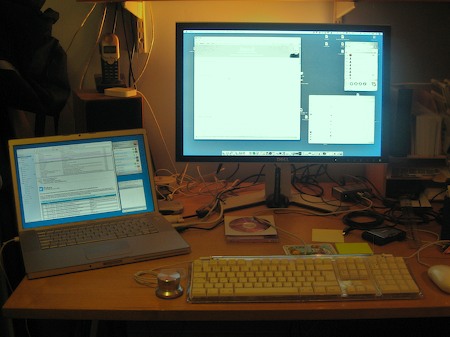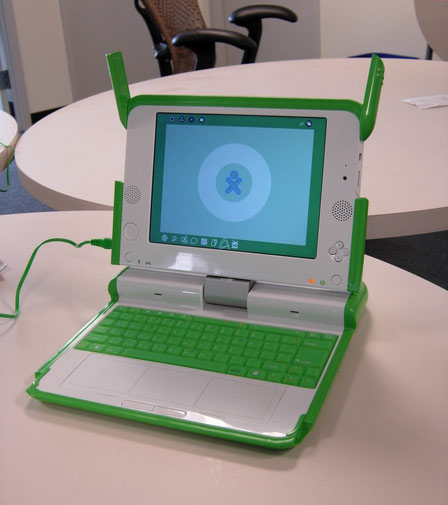Lots of activity on our bird feeder this morning:
One Distraction Per Child?
Duncan Goldie-Scot pointed me at John C. Dvorak’s article: The $100 Laptop: What went wrong? Anyone familiar with JCD will recognise that the dismissive past tense for a project that is just warming up is simply part of his normal marketing style. He raises some good questions, though…
…I myself have moaned about the details of this One Laptop Per Child scheme as folly or idealistic. The basic argument is that with $100 you could almost feed a village for a year, so why waste that sum on a laptop? What are they thinking?
But Zachary has a more profound point: “The fact that these people need electricity more than they need a laptop is only part of the problem,” he says. “The real problem is lost mind share. The people are harmed because these sorts of schemes are sopping up mind-share time of the people who might be doing something actually useful.”
To summarize, there are only so many hours in the day, and we should not be wasting them on this kind of naïve feel-good showboating. Let’s face it: These high-tech gems are a laughable addition to a mud hut.
Classic Dvorak. (I’m very skeptical, in passing, about $100 being enough to feed a village for a year. I read a report on OLPC recently which said that average governmental spending in the countries concerned is around $200/head, so $100 spread over the laptop’s expected 5-year life sounds much more reasonable.)
However, I also don’t buy his larger argument, for various reasons.
The first is that different people are inspired to make the world a better place in different ways, and resources, innovation and people can’t be shuffled from project to project in quite such a simple fashion – inspiration is not subject to the rules of double-entry bookkeeping. Besides, this is an old story: In the seventies the big argument was that we shouldn’t be making weapons when there were people needing ploughshares. Today, people like me probably shouldn’t pay a premium for organic food when there are others going hungry in Africa. These are both true, but they are pie-in-the-sky arguments because nothing is that simple in reality. If my hotel decided not to have such a nice carpet in its lobby, would that mean that there were fewer homeless people on the streets? Of course not. And if the OLPC project weren’t there it doesn’t mean that the resources that RedHat, say, are putting into it would automatically be diverted to water purification.
The second is that it can be rather too easy for the wealthy part of the world to decide the priorities for the less wealthy part. Perhaps the best example that I’ve come across in my work is the spread of mobile phones. Did you know that over a third of the world’s population have a mobile phone now? The number is growing by more than a million users per day, and it will be less than five years before half the world have cellphones. “Why on earth”, we might have asked ten years ago, “would somebody in an African village with a poor water and electricity supply want a mobile phone?” But that’s because we take for granted things like the ability to travel, or the reliability of postal services, and forget that the simple ability to transmit and receive information over a distance is incredibly empowering. Mobile phones are transforming millions of lives. We don’t know exactly how people around the world would use a PC if they had access to one, but it is one of mankind’s most sophisticated and flexible tools, and I don’t think it’s our place to deny it to others.
I have many questions about OLPC, some of which we’re trying to address at Ndiyo. I doubt that it will succeed on the scale that its founders hope. And I think there’s a good argument that, for example, Dean Kamen’s latest initiative around water purification and electricity generation is rather more important than both projects.
But I have huge admiration for people who dream a big impossible dream and work hard to make it a reality. Give me the option of a world with more well-intentioned visionaries, or a world with more armchair cynics, and I know which one I’d choose!
Lasse Gjertsen
Lasse Gjertsen claims that he can play neither drums nor piano. But, boy, can he edit a video!
Rings
An ace up 007’s sleeve
I must confess I felt that the last Bond film was evidence that the franchise was in terminal decline, and after seeing it decided I probably wouldn’t bother with any future ones.
But then, through a slight connection with a charity of which Judi Dench is a patron, we had a chance to get early preview tickets for Casino Royale, and went to see it tonight. And I have to say that my faith has been restored. This is not just a significant improvement on the last couple of movies – I think it could qualify as one of the best of the bunch.
It’s rather more serious than most Bond films because they’ve cut much of the buffoonery. Fond as I am of John Cleese, for example, I always thought him a little out of place, and wasn’t sad to lose him. The acting is good and the script well above average; chiefly, perhaps, because it is remarkably close to Fleming’s original story.
Recommended.
As an aside, though, every time I’ve been to a film in the last few years I’ve found them almost painfully loud, with the exception of those in our local arts picturehouse. Does that just mean I’m getting old, or is the volume creeping ever upwards? I’m going to try and borrow a decibel meter from somebody next time I go. In the meantime, it’s just one more reason to watch things at home. Perhaps the cinemas think that demonstrating the power of their amplifiers is a way to emphasise their difference from home cinema. Well, it worked, but not quite in the way they wanted!
It’s green. It’s very green.
The first real prototype devices from the One Laptop Per Child project are coming off the production line.
More pictures here.
Bias lighting
I’d heard a bit about bias lighting recently so decided to try it. The basic idea is that, instead of your monitor being a bright square on a dark background, you put some lights behind it so that your eyes have a more consistent brightness level to deal with. I just found an old spotlight with a dimmer switch and stuck it behind my screen – not exactly the most sophisticated installation:

But I have to say, I’m a convert. I haven’t done any scientific tests here, but my impression is that I can read my screen for much longer in the evenings with much less strain. The idea makes sense, after all, and I think it probably does work.
Here’s some discussion about the topic.
Quick film review
The Prestige. Saw it last night. Loved it. Recommended.
Defensibility
Last month Guy Kawasaki wrote about the good and the bad answers to the question “What makes your startup defensible?”. His first point is that patents aren’t really much use unless you’re in “biotech, chip design, and medical devices where a patent really means something”. As he puts it, ‘”suing Microsoft” isn’t a viable (or attractive) business strategy’. It’s a good read.
When some patent attorneys responded to his comments, he also published their response. Excerpt:
Factor in some of the higher backlogged tech areas such as web business and Internet business methods, and it will realistically be at least five years before the Patent Office even starts to examine your application.
We’ve even heard of delays up to and beyond ten years in certain technology areas. Your competition could run you over by then, and it’s more than likely we’ll all be onto Web 5.0 by the time you get the pretty ribbon copy of your patent.
But they offer some good reasons why they’re “not changing our day jobs anytime soon” because “patents still play an important role in building a defensible business — �they’re just not the whole enchilada”. It’s also worth reading if you play in this space.
Phonecasting
Some questions for you:
- How often do you use the speakerphone facility on your mobile? If you’re like me, only very occasionally.
- How often do you get the urge to listen to music through the (probably mono) speaker or headset on your mobile? Again, I would suggest, probably not often. Even the cheapest iPod will do a much better job.
- How often, when listening to podcasts while shaving, do you wish that your iPod had built-in speakers so you don’t have to keep plugging it into those speakers with the battery that runs down and makes Leo Laporte sound like a dalek? Well, there may be fewer of you here, but I’m sure you can at least sympathise with those of us for whom this is a source of distress.
So I’m quite intrigued by the new software that I’ve just installed on my Nokia E61: Nokia’s Podcasting application. This is not, as the name might suggest, something that lets you create podcasts on the phone, but something that lets you subscribe to, download and listen to them. And the phone’s audio, limited and monophonic though it may be, is just fine for most podcasts, either through earphone or through the loudspeaker – speech is what it was designed for, after all!
This would also be a good way to generate phenomenally large phone bills if I were charged per megabyte for my 3G connection, or if I couldn’t set the phone to do the downloads via my wifi connection. And I’ll have to watch my settings carefully. My real worry is that I’ll accidentally go abroad and the application will download the latest episode of TWiT over a roaming GSM connection, which would, I calculate, cost me something in the region of £280.
Escape on a Donkey
Due to a slight linguistic error, Scottish fire services are encouraging people to escape from burning buildings on a donkey.
Ammo with flavor
Tired of discovering little bits of lead shot in your roast partridge? You need Season Shot:
Season Shot is made of tightly packed seasoning bound by a fully biodegradable food product. The seasoning is actually injected into the bird on impact seasoning the meat from the inside out. When the bird is cooked the seasoning pellets melt into the meat spreading the flavor to the entire bird.
I’m wondering what would have sufficient density to work as shot and yet still be edible…
© Copyright Quentin Stafford-Fraser

Recent Comments